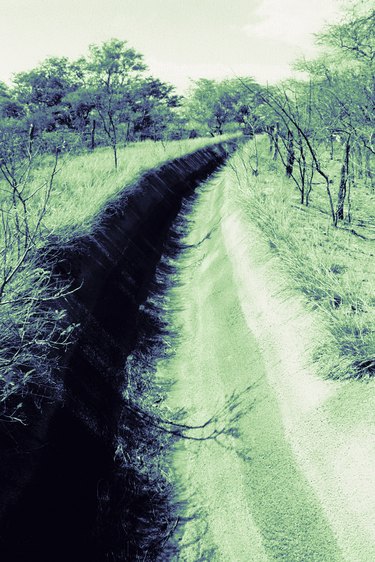
Plants placed along the sides of a ditch provide many benefits. They slow erosion both above and belowground with their roots and their foliage. They prevent run-off, which carries away soil and contaminants into waterways and increases pollution levels. They help stabilize slopes and direct water movement. Ditch planting presents some challenges, among them difficulty in accessing plantings for maintenance. Avoid this issue by choosing low-maintenance species well-suited for the soil, sunlight and climate of your particular planting site.
Shrubs
Video of the Day
Slow-growing shrubs of varying heights have strong root systems that help hold ditch sides in place. Avoid planting shrubs in straight rows; rather, plant in staggered groupings, as this slows water flow down the slope. Appropriate ditch-side shrubs include creeping juniper (Juniperus horizontalis), a 2-foot-tall evergreen that spreads up to 10 feet wide. This hardy shrub tolerates poor soil and thrives in full sun. The Japanese yew (Taxus cuspidata) and Taunton yew (T. x media "Tauntoni") also grow well in sloping sites. These evergreens tolerate a range of site conditions, drought and urban pollution. The Japanese yew grows to 6 feet tall and the Taunton reaches heights of 5 feet, both with slightly wider spreads.
Video of the Day
Ornamental Grasses
Ornamental grasses hold ditch banks in place with their spreading, fibrous root systems. These plants require little maintenance and many tolerate drought and a range of site conditions. For wet sites, choose Garrison's creeping foxtail (Alopecurus arundinaceus "Garrison's") or reed canarygrass (Phalaris arundinacea). Both tolerate wet feet and spread quickly. Reed canarygrass comes in a variety of cultivars, including variegated, pink, white and yellow foliage. Switch grass (Panicum virgatum) also grows well on ditch banks . This native grass tolerates wet to dry soil and sun to partial shade exposures. Its blue-green, clumping foliage turns red in fall and it attracts wildlife with its seeds. For drought-prone areas, plant sheep or red fescues (Festuca ovina or rubra). These low-maintenance grasses grow to 2 feet tall and don't require mowing. They tolerate drought, shade and sandy, poor soils.
Deciduous Ground Covers
Ground covers spread much wider than they grow tall. Deciduous plants lose their foliage in winter, but their roots continue to stabilize soil. Choices for ditch banks include bird's foot trefoil (Lotus corniculatus), a 12-inch-tall perennial that blooms with yellow flowers. This tough plant spreads up to 2-1/2 feet per growing season and tolerates drought, heat, salt and a range of soil pH levels. Crown vetch (Coronilla varia), a perennial legume, controls erosion on steep slopes. It spreads very rapidly up to 6 feet wide and thrives in sun to shade. Crown vetch can become invasive if allowed to grow unchecked.
Evergreen Ground Covers
Evergreen ground covers keep their foliage in winter, proving year-round color and texture. Dead nettle (Lamium maculatum) spreads quickly to form a carpet of toothed, variegated foliage. This evergreen thrives in cool, shady sites with acidic soil. Stonecrop or sedum (Sedum spp.) grow well on sunny ditch banks. Stonecrop species range in size from a few inches to 2 feet tall but all spread or creep. Sedum can be evergreen or semi-evergreen and grow in a variety of colors and sizes.
- Washington State University; Gardening on Steep Slopes; April 2005
- Virginia Cooperative Extension; Selecting Landscape Plants: Ground Covers; Diane Relf, et al.
- University of Minnesota Extension; Ground Covers for Rough Sites; Mary H. Meyer, et al.; 2009
- NC State University: Index of All Plant Fact Sheets - Scientific Names
- North Carolina State University; Plants for Steep Slopes; T.E. Bilderback. et al.; July 1996